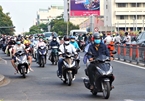|
Developed countries will be hit the hardest, with an average decrease of up to 6.1%. Emerging and developing economies are more sheltered, ebbing by about 1%. Only a few economies are predicted to post slight growth this year. These figures partly reflect Covid-19’s detrimental impacts on the world’s economy. Vietnam’s economy is not an exception. GDP growth in the first quarter was only 3.82% year-on-year, the lowest during the past 11 years. It is still relatively commendable given the downturn that most countries have experienced. However, they do not fully reflect the challenges haunting the economy since many export orders have been affected since March only and social distancing has been strictly enforced in Vietnam only since the beginning of the second quarter. In particular, the growth figures exclude the informal economy, which is barely included in GDP. Agriculture and mining have posted negative growth in the first and second regions due to climate change, diseases and adverse conditions in the global market for mining products. Manufacturing industries posted laudable growth (+7.12%), but second-quarter prospects are rather gloomy as the number of new orders dropped to only 41.9 points in March, below the median of 50 points. Service was hit the hardest by border closure and social distancing. Some sectors that posted negative growth in the first quarter include accommodation and food & beverage (-11.0%), finance and supporting industries (-3.5%), as well as transport and warehousing (-0.9%). These industries are expected to continue plunging in the second quarter, when precautionary measures are intensified. Demand has fallen, too. Many sectors are reliant on external sectors, so although they still clocked up growth, drastic damage was recorded in the first quarter, especially since March, when the export value of some industries has fallen significantly. Vietnam’s total export value in the first quarter of 2020 rose by 8.1% year-on-year and its trade surplus was US$3.84 billion. However, Vietnam’s biggest export markets will be adversely affected in the future when the U.S. has just adopted social distancing since the end of March and the disease is spreading in European Union (EU) countries. Demand from China and Japan will be less encouraging than in the first quarter since China has started production again and Japan has declared a nationwide state of emergency due to Covid-19 since April. Growth prospects in 2020—4.2% in the rosy scenario Vietnam’s economic prospects in 2020 and beyond hinge on the ability to control the pandemic nationally and globally. The rosiest scenario is based on the assumption that Covid-19 is completely under control in Vietnam in mid-May and economic activities start to recover. However, many sectors, especially tourism, accommodation and transport have just started to improve. The most deleterious effect of Covid-19 will take place in the second quarter, with a decrease of 2-3% in agriculture, forestry and fishery. Manufacturing industries may face negative growth for the first time due to supply disruption and export order cancellation and delays. Transport, warehousing, accommodation, food and beverages, as well as art and entertainment will face a drastic drop (20-50%). Meanwhile, health care, the media, finance, banking and insurance can maintain stable growth by virtue of activities pertaining to disease prevention and damage control. In this rosy scenario, Vietnam’s economic growth is forecast at about 4.2% in 2020. In the neutral and pessimistic scenarios, the disease is assumed to continue affecting Vietnam until the third or fourth quarter of 2020. The world may need to continue with lockdowns and social distancing due to the recurrence of Covid-19 in many economic and financial hubs. Vietnam’s economy may grow by only 1.5% in the neutral scenario and -1% in the pessimistic scenario. Regardless of scenario, it will be difficult for sectors such as aviation, tourism and fashion export to fully recover in Vietnam in the period following Covid-19 if other countries have yet to keep this disease under control. Enterprises must try to adapt and transform their production. For example, the apparel industry can focus on making face masks and personal protective gear. In the short run, fueling public investment in the second half of this year may offset temporary issues plaguing production. Vietnam’s economic prospects in subsequent years hinge on whether a vaccine or successful treatment can be found. It is noteworthy that GDP growth does not fully reflect the challenges facing the economy since the informal sector, which is severely affected, is excluded. Lockdowns and social distancing have caused this sector, estimated at about 30% of GDP, to almost shut down. Policy focus A protracted budget deficit over the past decades means that Vietnam’s fiscal resources are limited. Even when the economy boasts sizzling growth and budget revenue soars, the Government’s spending outpaces revenue by about 3.5% of GDP. Consequently, Vietnam lacks fiscal buffers to respond to financially intensive shocks such as Covid-19. Moreover, monetary policy is constrained by inflation and forex targets. Given resource constraints, Vietnam’s policies should be focused to avoid profligacy. Vietnam has promptly and actively battled Covid-19. However, the longer social distancing measures take place, the higher the economic costs will be. Meanwhile, the disease persists. Regardless of scenario, Vietnam must come up with disease prevention measures while supporting production instead of imposing a total ban on every sector as in the case of some localities. Economic growth aimed at minimizing the harmful impacts of Covid-19 should be given as much priority as fighting the disease. Social security measures such as unemployment benefits, support for those temporarily out of a job, as well as subsidies for the poor and those whose livelihood is affected by social distancing should be the priority and must be implemented quickly before tragedies occur. In particular, those in the informal sector should be given more attention since they take up a significant share of the workforce, are vulnerable and may not qualify for existing support. Meanwhile, support for enterprises should be differentiated. Exemption or reduction of financial costs such as interest rates and land rents should apply to firms that must cease operations. Lower land rents, postponement in social security payments, debt restructuring, interest rate reduction and value-added tax payment extension should apply to firms affected by the crisis but still in operation, subject to clearly defined criteria. Companies that are barely affected by the crisis since they have adapted well should be offered credit incentives and institutional support since they have the pillars of the economy at the moment. Even when Covid-19 is under control domestically, many export-oriented sectors may still face long-term challenges if the disease has not vanished from economic and financial hubs worldwide. Boosting public investment in the second half of 2020 will therefore be critical. However, it does not mean expanding public investment uncontrollably. Vietnam should focus on projects that are nationally important, already approved and financially ready. Perhaps a project can be broken down into smaller contracts to be carried out across localities, so that more firms can enjoy business opportunities and the multiplier effect will increase. At the same time, a reduction in regular spending (at least 10%) should be considered so that there will be resources to rectify the negative consequences triggered by the pandemic. Ultimately, together with short-term measures to deal with Covid-19, Vietnam should embrace long-term strategies that transform its macroeconomic foundations and reduce risks in the future. Inflation, the interest rate and the exchange rate must remain stable to pave the way for a post-pandemic recovery. Many flaws in economic policy management have arisen, so efforts to improve business institutions and environment should be sustained. In particular, Vietnam should gradually develop fiscal buffers to guard against shocks such as Covid-19; it is better late than never. SGT Dr. Pham The Anh (Chief economist of VEPRJ) |
||

Restart the economy, while keeping clear of COVID-19: PM's Decree 19
Prime Minister Nguyen Xuan Phuc on Saturday issued a new set of guidelines on measures to keep the country clear of COVID-19 while its economy restarts after strict social distancing measures were relaxed.

Digital economy expected to add 30% to GDP by 2030
The country wants to raise the digital economy’s contribution to gross domestic product (GDP) to 20 per cent by 2025 and 30 per cent by 2030.
 In a recent report on global economic prospects in mid-April 2020, the International Monetary Fund forecasts that the world’s economy will slide by about 3%.
In a recent report on global economic prospects in mid-April 2020, the International Monetary Fund forecasts that the world’s economy will slide by about 3%. 